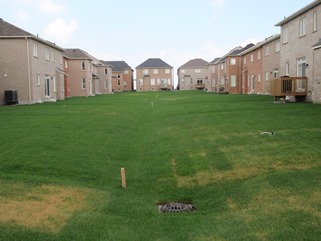Evaluation of Residential Lot Level Stormwater Management Practices
 Lot level stormwater management practices (i.e. source controls) include engineered structures such as rain gardens, soakaways and permeable pavements that filter, infiltrate and evaporate runoff. They can also include non-structural practices such as directing roof drainage to gently sloping landscaped areas (i.e. lawns) that contain topsoil of sufficient depth, quality and permeability to infiltrate and evaporate a significant portion of runoff during wet weather. While the runoff reduction performance of individual lot level practices is becoming well understood, little information is available that quantifies overall benefits associated with widespread implementation of these practices at a catchment (i.e. community) scale. Although draining roofs to landscaped areas is standard for new residential developments, not much is known about the effectiveness of this practice to manage runoff. Furthermore, there is little known about how much more effective it could be by increasing topsoil depth and quality in landscaped areas receiving roof drainage.
Lot level stormwater management practices (i.e. source controls) include engineered structures such as rain gardens, soakaways and permeable pavements that filter, infiltrate and evaporate runoff. They can also include non-structural practices such as directing roof drainage to gently sloping landscaped areas (i.e. lawns) that contain topsoil of sufficient depth, quality and permeability to infiltrate and evaporate a significant portion of runoff during wet weather. While the runoff reduction performance of individual lot level practices is becoming well understood, little information is available that quantifies overall benefits associated with widespread implementation of these practices at a catchment (i.e. community) scale. Although draining roofs to landscaped areas is standard for new residential developments, not much is known about the effectiveness of this practice to manage runoff. Furthermore, there is little known about how much more effective it could be by increasing topsoil depth and quality in landscaped areas receiving roof drainage.
Completed in the fall of 2012 this study helps to address these knowledge gaps by evaluating at a catchment scale, the hydrologic benefits of widespread application of two types of lot level stormwater management practices in a newly constructed residential development in Markham, Ontario:
• Increased topsoil depth; and
• Rear yard infiltration trenches with grass swale pretreatment.
Runoff reduction benefits were examined relative to a control catchment of conventional design (standard topsoil depth and no rear yard infiltration trenches) and similar slope, soil type and impervious cover as the catchments where increased topsoil depth and rear yard infiltration trenches were implemented. The field monitoring program included measurements of precipitation depth, water level in each infiltration trench and flow rate and volume in the storm sewers at catchment outlets. To verify conclusions drawn from the catchment scale evaluation of increased topsoil depth and to characterize what further benefits could be achieved with addition of a compost blanket amendment (i.e. increased topsoil depth and quality), evaluations of test boxes designed to simulate turf grass landscaped areas exposed to natural precipitation were also conducted.
At the catchment scale it was found that increasing topsoil depth in rear yard areas from the standard 10 to 15 cm to 30 cm and up to 120 cm in a grassed swale along rear property lines resulted in 5% less runoff depth being generated from the Increased Topsoil Depth catchment than the Control during rain events of 15 mm depth or greater over the two and a half year monitoring period. While these results support widespread implementation of this simple, inexpensive practice, they also suggest that application of increased topsoil depth in rear yard areas alone, with no effort made to reverse subsoil compaction prior to topsoil spreading, nor to amend site topsoil with compost to increase organic matter content, only provides minor runoff reduction benefits.
Due to several deficiencies in how the infiltration trenches were implemented it was found that at least one of the three trenches did not receive runoff from its drainage area over the monitoring period and that very minor runoff reduction benefits were detectable in the Rear Yard Infiltration Trenches catchment.
Results from the test box scale evaluations support the hypothesis that pervious landscaped areas do not generate substantial volumes of runoff during small to medium size storm events that are less than 15 mm in depth. They also confirm that the practice of applying increased topsoil depth (25 to 30 cm) to grassed pervious areas should produce less runoff than a standard 10 cm depth and that additional runoff reduction and water storage benefits can be provided by amending topsoil with compost. Based on observed differences in soil moisture over the monitoring period, applying a compost blanket amendment to topsoil in pervious areas prior to laying sod or planting grass seed would provide the additional benefit of creating a more drought tolerant, lower maintenance lawn that can survive for longer periods without irrigation.
